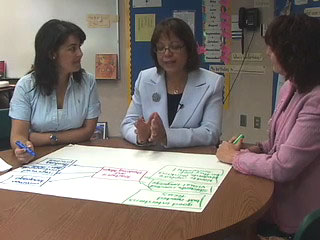



 Research - Case Studies - McKinley Elementary School
Research - Case Studies - McKinley Elementary SchoolChanging Methodology
Teachers have changed their methodology as evidenced by their lesson plans after being trained in Thinking Maps®.
Prior to Thinking Maps®, lesson plans reflected activities for students to perform instead of developing their higher level thinking skills. By comparing the lesson plans before and after Thinking Maps® training, we will demonstrate that teachers have changed their instructional paradigm.
Teachers have changed their methodology as evidenced by their lesson plans after being trained in Thinking Maps. Examples of teachers lesson plans can be downloaded as pdf files:
- Kindergarten lesson plans (pdf file)
- 1st Grade lesson plans (pdf file)
- 2nd Grade lesson plans (pdf file)
- 3rd Grade lesson plans (pdf file)
- 4th Grade lesson plans (pdf file)
- 6th Grade lesson plans (pdf file)
Watch Part 2 of a 3 Part interview with McKinley principal Aurora Garcia. Aurora was interviewed by staff members Joy Wenke and Maria Rivero who were research team collaborators.
![]() Watch the video clip with Aurora Garcia: part 2 - Differentiation and Thinking Maps® in Quicktime (7:14)
Watch the video clip with Aurora Garcia: part 2 - Differentiation and Thinking Maps® in Quicktime (7:14)
As stated previously, lesson plans were focused around activities not thinking skills. Throughout the process of learning how to implement Thinking Maps®, teachers voluntarily began to show evidence of Thinking Maps® in their lesson plans. Based on the standards needed to be taught, teachers began to indicate the thought processes that relate to each Thinking Map®. (See digital examples)
From these plans we can infer that the Teacher’s Manuals have become a reference in teacher’s planning but not the principal focus.
Teachers are using meta-cognition in planning their lessons. They are thinking about their student’s thinking processes. The Thinking Maps® have given the teachers the power to acknowledge student individuality and voice by allowing each student to choose how to visually represent their thinking.
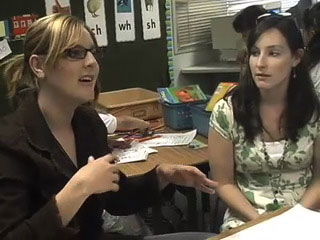
![]() Watch the video clip in Quicktime (5:44)
Watch the video clip in Quicktime (5:44)
![]() Watch the video clip in Windows Media Player (5:44)
Watch the video clip in Windows Media Player (5:44)
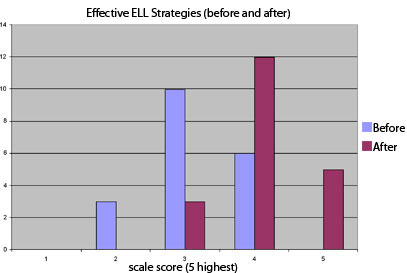
![]() Before T.M. came to McKinley how effective were your instructional strategies for the ESL?
Before T.M. came to McKinley how effective were your instructional strategies for the ESL?
![]() After T.M. came to McKinley how effective were your instructional strategies for the ESL?
After T.M. came to McKinley how effective were your instructional strategies for the ESL?
The majority of teachers felt effective in ELL teaching strategies prior T.M. trainings (list other trainings). Clearly the teachers indicated that T.M. training has given them more effective strategies for ELL students.
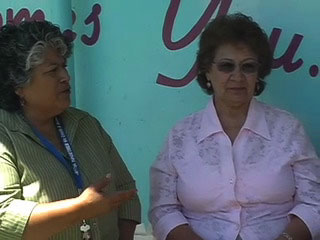
Interview with veteran teachers Lupe and Lucia with research leads Maria and Joy.
![]() Watch the video clip in Quicktime (12:04)
Watch the video clip in Quicktime (12:04)
![]() Watch the video clip in Windows Media Player (12:04)
Watch the video clip in Windows Media Player (12:04)
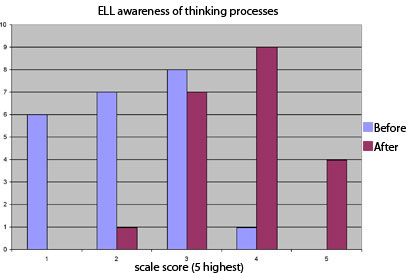
![]() Before T.M. training and coaching, to what degree were your ELL students aware of the thinking processes during instruction time?
Before T.M. training and coaching, to what degree were your ELL students aware of the thinking processes during instruction time?
Giving the data, teachers overall felt that ELL students were not aware of the thinking processes before T.M. training.
![]() After T.M. training and coaching how would you rate your ELL students’ awareness of their thought processes?
After T.M. training and coaching how would you rate your ELL students’ awareness of their thought processes?
The graph indicates the staff from McKinley School feels that ELL students are significantly more aware of the eight thinking processes. From this graph we can conclude that teachers feel that the students are not yet completely aware of the thinking processes during instruction time. One of the goals for the teaching staff at McKinley could be that all teachers feel the majority of their ELL students are aware of the eight thinking processes.
The after-school program teachers at McKinley CORAL (Communities Organizing Resources to Advance Learning) have been trained in Thinking Maps®. This has resulted in more effective after-school teachers, increased collaboration and communication between the “regular” school day and the “after-school” program. See videoclip of After-school teachers and the Director Maritza Maldonado
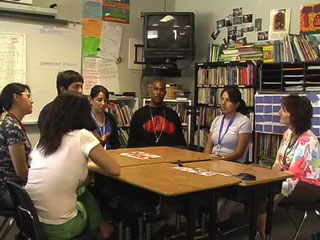
CORAL after school program teachers.
![]() Watch the video clip in Quicktime (8:30)
Watch the video clip in Quicktime (8:30)
![]() Watch the video clip in Windows Media Player (8:30)
Watch the video clip in Windows Media Player (8:30)
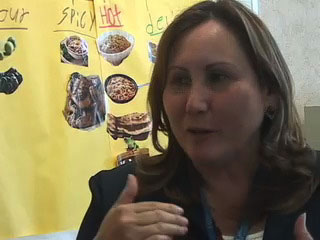
After school CORAL program - an interview with Maritza Maldonado, Director of Educational Services, Catholic Charities of Santa Clara County.
![]() Watch the video clip in Quicktime (7:12)
Watch the video clip in Quicktime (7:12)
![]() Watch the video clip in Windows Media Player (7:12)
Watch the video clip in Windows Media Player (7:12)
See the Menu on the left column at the top of this page for more sections in this case study on McKinley Elementary School in San Jose, California.
